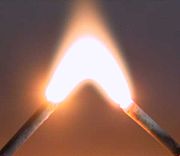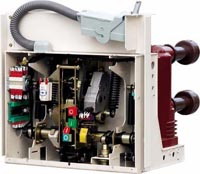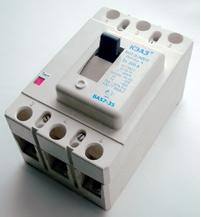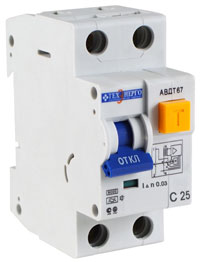How arc extinguishing works in circuit breakers
Types of arc extinguishing devices in circuit breakers
The circuit breaker must provide arc extinguishing under all possible network conditions.
Two versions of arc extinguishing devices have found application in circuit breakers - semi-closed and open.
In the semi-closed version, the circuit breaker is covered by a housing with openings for the escape of hot gases. The volume of the casing is large enough to avoid large overpressures inside the casing. In the semi-closed version, the hot and ionized gas emission zone is usually a few centimeters from the exhaust openings. This design solution is used in automatic circuit breakers installed next to other devices, in switchgear, in manually operated machines. A current-limiting circuit breaker does not exceed 50 kA.
At currents of 100 kA and higher, open chambers with a large discharge area are used in circuit breakers.The semi-closed design is used, as a rule, in assembly and universal automatic machines, open — in high-speed and automatic machines for high limiting currents (100 kA and more) or high voltages (over 1000V).
Methods of extinguishing an electric arc in installation and universal circuit breakers
 In circuit breakers for mass use (installation and universal), a deionic arc grid made of steel plates is widely used. Insofar as circuit breakers are required to operate on both AC and DC, the number of plates is selected by the tripping condition constant current circuit... Each pair of plates must have a voltage of less than 25 V.
In circuit breakers for mass use (installation and universal), a deionic arc grid made of steel plates is widely used. Insofar as circuit breakers are required to operate on both AC and DC, the number of plates is selected by the tripping condition constant current circuit... Each pair of plates must have a voltage of less than 25 V.
In AC circuits with a voltage of 660 V, such arc devices provide arc extinguishing with a current of up to 50 kA. At direct current, these devices operate at voltages up to 440 V and cut currents up to 55 kA. With steel plate arc quenchers, quenching is quiet, with minimal release of ionized and heated gases from the arc quencher.
Types of circuit breaker arc chambers
For high currents, chambers with labyrinth slits and straight longitudinal slit chambers are used. The arc is drawn into the slot by magnetic blowing with a current coil.
A longitudinal slit chamber may have several parallel slits of constant cross-section. This reduces the aerodynamic drag of the chamber and makes it easier for the high current arc to enter the slots. First, the arc is divided into a series of parallel fibers. But then, of all the parallel branches, only one remains, in which extinction finally occurs. Chamber walls and partitions are made of asbestos cement.

In the labyrinth slit chamber, the gradual entry of the arc into the zigzag slit does not create high drag at high currents. A narrow gap increases the voltage gradient in the arc, which reduces the required arc length for quenching. The zigzag shape of the slot reduces the size of the machine.
In the chamber with a labyrinth slit, the arc is intensively cooled by the walls of the chamber. Due to the fact that the arc emits a large amount of heat on the walls of the slit, the material of the chamber must have a high thermal conductivity and melting point.
 To prevent the chamber from being destroyed by high temperature, it is necessary to keep the arc moving continuously at a high speed. This requires the creation of a powerful magnetic field along the entire path of the arc in the slot. If the speed is insufficient, the arc extinguishing device is destroyed.
To prevent the chamber from being destroyed by high temperature, it is necessary to keep the arc moving continuously at a high speed. This requires the creation of a powerful magnetic field along the entire path of the arc in the slot. If the speed is insufficient, the arc extinguishing device is destroyed.
Cordierite is used as the chamber material. Gas-forming materials such as fibers, organic glass are not used due to increased aerodynamic drag.
Currently, to simplify the design (rejecting powerful and complex magnetic detonation systems), they are returning to the idea of a deion steel grid. Steel plates with a groove for arcing contacts create a force that moves the arc. Unlike a conventional grid, the arc is in contact with insulated steel plates: extinguishing occurs in the same way as in a chamber with transverse insulating partitions, but without a special magnetic system that moves the arc.
The influence of an electric arc on automatic contact switches
 The most critical part of an automatic circuit breaker are contacts.At rated currents up to 200 A in automatic mode, the circuit breakers use one pair of contacts, which can be lined with metal ceramics to increase the arc resistance.
The most critical part of an automatic circuit breaker are contacts.At rated currents up to 200 A in automatic mode, the circuit breakers use one pair of contacts, which can be lined with metal ceramics to increase the arc resistance.
Large rated currents require automatic application of two-stage contact breakers of the movable bridge type or a pair of main and arc contacts. The main contacts of the circuit breakers are lined with silver or metal-ceramic (silver, nickel, graphite). The fixed arc contact is covered with SV-50 metal ceramics (silver, tungsten), removable SN-29GZ. Cermet and other brands are used in automatic switches.
In circuit breakers for high rated currents, the inclusion of several parallel pairs of main contacts is used.
In high-speed circuit breakers, in order to reduce their own time, only end contacts with low immersion are used. The contacts are made of copper and the contact surfaces are silver. Due to the increase in the rated current and the relatively high contact resistance of automatic switches, work is currently being done on the artificial cooling of the contacts using a liquid. This solution to the problem allows you to maintain low weight and performance. circuit breaker and increase the continuous current from 2500 to 10000 A.
Stability of contacts of automatic switches in case of short circuit
 Stability of breaker contacts when switched on for short circuit depends on the rate of pressure rise in the contacts. When the amplitude of the included current is more than 30-40 kA, moment action machines are used, in which the speed of movement of the contacts and the pressure in them do not depend on the speed of movement of the switch handle.
Stability of breaker contacts when switched on for short circuit depends on the rate of pressure rise in the contacts. When the amplitude of the included current is more than 30-40 kA, moment action machines are used, in which the speed of movement of the contacts and the pressure in them do not depend on the speed of movement of the switch handle.
In selective universal circuit breakers, a deliberate time delay is created when a short circuit current is flowing.
In order to avoid welding of the breaker contacts, electrodynamic compensation must be applied. When current flows in an arcing circuit to a conductor carrying a fixed arcing contact breaker, an electrodynamic force acts, increasing the pressure on the contacts.
